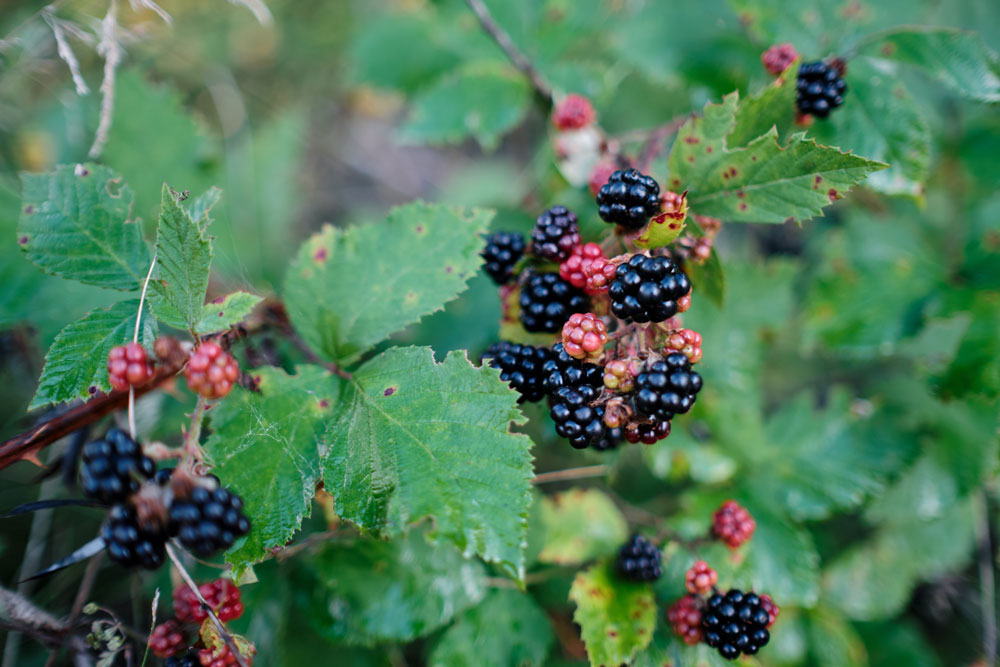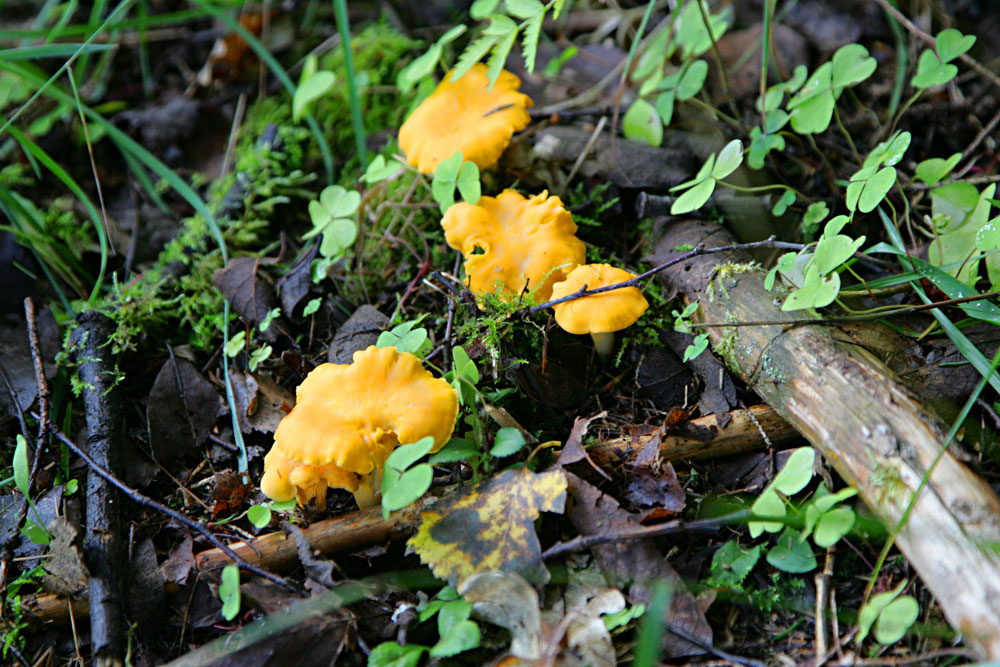Early summer provides great foraging opportunities, but this time of year is my favorite time to forage. It allows me to bring home some tasty, nourishing treats while scouting in preparation for the coming deer season. Finding a patch of blackberries or hitting the motherlode of chanterelle mushrooms is a forager’s gold mine.
Let’s go foraging!
Wild Blackberries

Blackberries are by far my favorite berry. I love to find a patch of the sweet berry with a hint of bitter kick while scouting during the summer months. As a perennial, when finding a good patch, take note to return year after year.
Identification
Blackberries are easy to identify, as wild blackberries look just like their domesticated counterparts. Although, they may often be a little smaller and not quite as sweet than those found in the produce aisle.
Harvesting and storing
Young blackberries grow red but as they ripen, they turn a deep purple, almost black when they are ready to harvest. Once they turn dark they can be picked easily.
Once off the vine, blackberries will mold within a couple days if not refrigerated. Also, do not wash until ready to use as washing can promote mold and decrease freshness.
If planning to use within a few days they can be stored in the fridge. But if it will be more than a few days it is best to freeze them unwashed. When ready to use, thaw and then rinse just before eating or cooking.
Health benefits
The berry is full of antioxidants and vitamins. One cup contains 50 percent of the daily recommendation of Vitamin C in only 62 calories. Leaves of the blackberry are used to treat digestive problems. Dried leaves make a great tea to promote healthy digestion and has long been used as a cure for diarrhea.
Use
Blackberries can be eaten fresh off the vine if they have not been sprayed. This is a great way to introduce foraging to others including our kids.
Blackberries are commonly used in desserts and jams. Personally, we stay away from excessive sugars and enjoy Blackberry Chia Jam with its simple ingredients and is loaded with nutrition being sweetened with local honey.
Caution
If we look close enough, it’s easy to identify blackberry pickers by cuts and scratches from the thorny brambles. Poison Ivy also enjoys similar conditions as blackberries. Also, many critters, including bears, like to eat blackberries and snakes like to nestle themselves in and around blackberry bushes. So it is wise to wear long sleeves and boots, possibly snake gaiters, while making a little noise and spraying down for ticks.
It takes some work and maybe a few catches, but wild blackberries are a delicious treat. With a fourth of commercial blackberries grown in Russia then sprayed with various chemicals to prevent their natural breakdown, we will stick to eating what we forage.
Chanterelle Mushrooms

Often referred to as “golden chanterelle” and rightfully so because they are worth their weight in gold. Chanterelles taste amazing and have a golden color and often sell for more than $60 a pound. Foraging chanterelle mushrooms in the wild are a very special treat to bring home.
Identification
Chanterelles are golden, ranging in color from yellow to deep orange. They are shaped like a funnel with a fleshy, wavy cap. The false gills under the cap appear as wrinkles that are forked and wavy with blunt edges. Chanterelles also have a very pleasant and sweet apricot aroma.
Harvesting and storing
Chanterelles are found in moist shady areas with plenty of organic matter. Normally found near hardwood trees, they will often seem to appear overnight when a good rain is followed by a couple days of hot heat. They are common in paths of rain drainage as spores are carried downhill.
Cutting with a knife or scissors near the base will decrease the amount of dirt to clean later, but also may have more growing later if the base is left in the soil. Once a good mess has been collected, store in the refrigerator until ready to clean.
Soaking chanterelles in water can cause them to become slimy. To clean, use a toothbrush under running water to gently brush the dirt and debris from the various folds of chanterelle. Allow them to dry on a paper towel before cooking.
Health benefits
Chanterelles are chocked full of vitamins and nutrients providing great anti-inflammatory properties. The high concentration of B vitamins helps to keep the nervous and immune systems strong and healthy. Plus they contain vitamin D, potassium, zinc, and copper. One cup is only 21 calories with over 2 grams of fiber.
Use
While they can be eaten fresh and raw, sautéing Chanterelles in butter makes them an irresistible treat.
Dried chanterelles can lose flavor and the texture of the slices often become rubbery when rehydrated. Sautéing in butter before freezing in an airtight container seems to be the best way to maintain the delicious flavor and texture.
Caution
As always when foraging, especially for mushrooms, double check your gatherings. If it is the first time, after sautéing the mushrooms, take one small bite and wait 10-15 minutes. This will allow you time to see if it upsets your stomach.
Make sure not to gather downstream from fields or heavily used roads that may pollute the ground with runoff water that may have chemicals and poisons that the mushrooms can absorb.
Watch chanterelle foraging, cleaning and cooking.

Need wild game meat for a recipe you've been wanting to try? Check out GameKeeper Butchery. GameKeeper Butchery is dedicated to procuring the finest assortment and highest quality of specialty meats from the United States and around the world. Our commitment is to deliver the safest, freshest and most wholesome products.




























